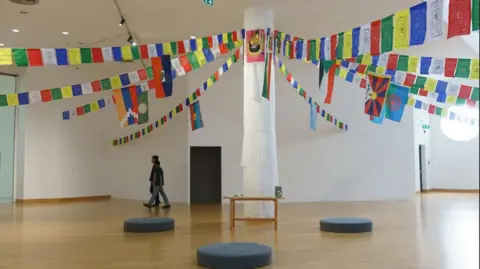The recent turmoil surrounding an art exhibition in Thailand has brought to light the lengths to which governments will go to silence voices critical of authoritarian regimes. Burmese artist Sai and his wife, who curated the exhibition titled “Constellation of Complicity: Visualising the Global Machine of Authoritarian Solidarity,” faced severe repercussions when their work appeared to irk the Chinese government. The couple fled to the United Kingdom seeking asylum after the exhibition, which showcased art from exiled artists from countries like China and Iran, was heavily censored. Their story speaks volumes about the ongoing struggle for artistic freedom in a world where political pressures can jeopardize the safety of artists.
The exhibition, held at the Bangkok Arts and Cultural Centre, opened on July 26, 2023. Shortly thereafter, representatives from the Chinese embassy, accompanied by city officials, visited the gallery, leveling complaints about specific artworks from Tibetan, Uyghur, and Hong Kong artists. Initially, they demanded the show be completely shut down. However, the gallery reached a compromise, resulting in the removal of several sensitive pieces and alterations that blurred out artists’ names and geographic references to politically sensitive regions such as Tibet and Xinjiang. Those who visited the exhibition reported seeing titles and artists’ names covered with black paint, a clear indication of the extent of censorship imposed on artistic expression.
In the wake of the censorship, Sai and his wife learned that Thai police were looking for them. They interpreted this as a direct threat to their safety, prompting a hurried escape from Thailand just days following their exhibition’s opening. Their fears were compounded by previous experiences in their home country of Myanmar, where Sai’s family has faced severe repercussions for opposing the military junta. Sai’s father, a former chief minister and member of the National League for Democracy, is incarcerated on what Sai claims are politically motivated charges. Given this history, the couple’s decision to abandon their lives in Thailand was fraught with urgency and fear.
Lord Alton of Liverpool, chair of the UK Parliament’s Joint Committee on Human Rights, commented on Sai’s predicament as an illustration of China’s transnational repression campaign. He condemned the pressure imposed on the Thai cultural center to censor the exhibition, viewing it as an infringement on the freedom of expression. Similarly, human rights advocates criticized the Thai government’s acquiescence to Chinese demands, arguing that it reflects a troubling trend toward suppression of artistic and cultural debates.
The Chinese embassy disputed claims regarding the suppression of the art exhibition, insisting that the displayed works did not represent the sentiments of the Chinese people and labeled them as promoting separatism. This diplomatic tension highlights the geopolitical intricacies at play and raises questions about the boundaries of free expression versus national sovereignty. While the current political environment may subject artists to immense pressure, those like Sai and his wife continue to fight their battles, fueled by a desire to shed light on oppressive regimes and advocate for those silenced in their homelands.
Despite the challenges they faced, Sai remained optimistic that the censorship had sparked broader interest in their exhibition. The couple plans to take their uncensored art show to other international venues after concluding their current run in Bangkok, which ends in October. Sai perceives the controversy as amplifying their message of resistance against authoritarianism, affirming that in the face of blatant censorship, artists find new ways to connect and engage an international audience. In a deeply interconnected world, the implications of this artistic struggle resonate far beyond the confines of a single exhibition, igniting discourse on freedom, expression, and human rights globally.
As the couple reflects on their escape and future plans, they remain determined to advocate for justice and resilience against repression. In doing so, they join a larger movement of artists and creatives resisting authoritarian narratives, underscoring the power of art as a tool for activism and change.












